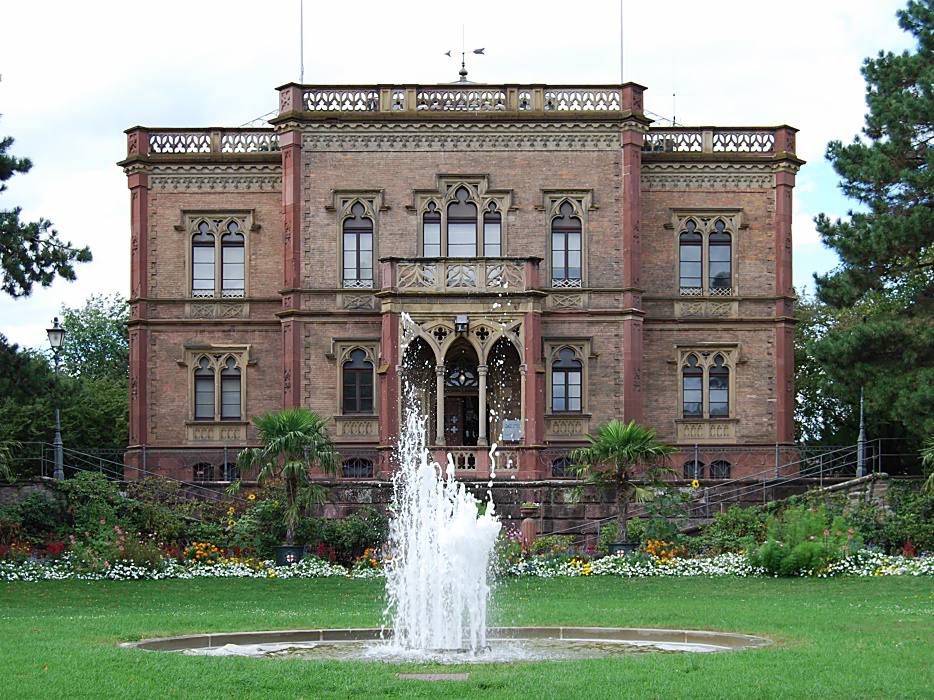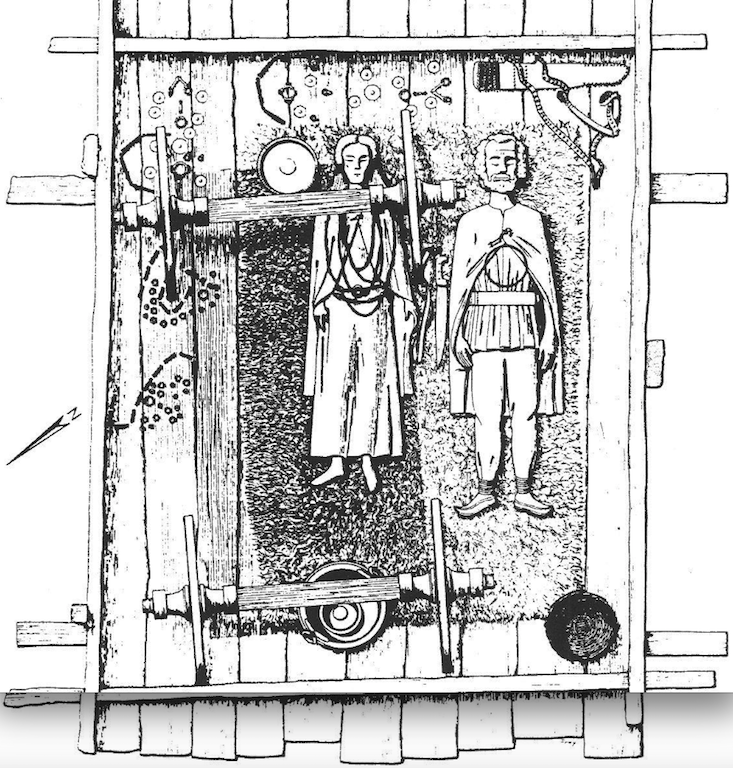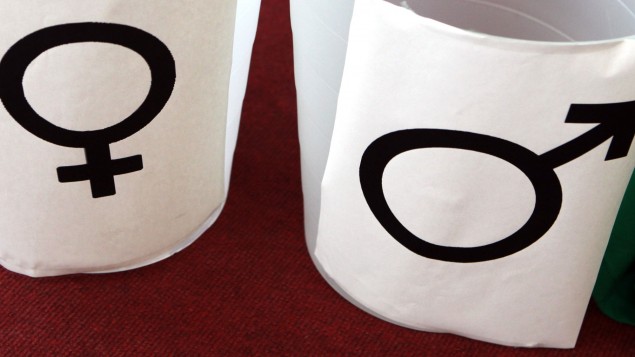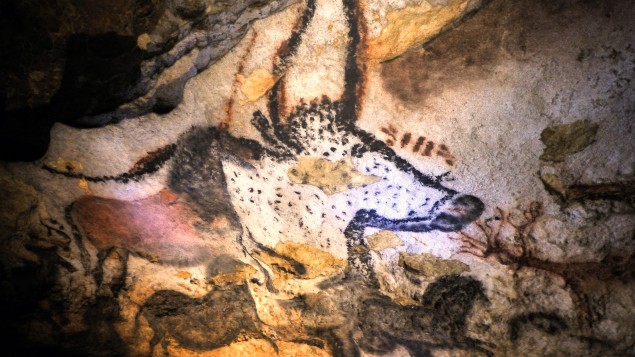I N T E R V I E W N R 1 W I T H B R I G I T T E R Ö D E R
by Anette Selg

In the Colombischlössle Museum in Freiburg; a little castle from the middle of the 19th century, which is being used as an archaelogical museum today, the archaelogist professor Brigitte Röder had the privelige to master an exhibition about gender research in archaeology, with the heading:
Ich Mann. Du Frau. Feste Rolle Seit Urzeiten?
G E S C L E C H T E R R O L L E N
Forscher entzaubern die Steinzeit-Klischees
Von Anette Selg
Article published in Deutschlandfunk Kultur 20.01.2016
G E N D E R R O L E S
Reasearcher Enchanting the Stone Age Clichés
Interview with the archaeologist Brigitte Röder by Anette Selg
Article published in Deutschlandfunk Kultur 20.01.2016
My transl:
The man went out hunting and the woman was staying at home in the cave taking care of the children. That´s the way it was during the stone age - or not. Female researchers make some remarks of doubt on that issue, and tamper thereby with an age-old cliché about gender.
Some years ago the directors of the Colombischlössle museum in Freiburg; Helena Pastor and Doktor Grimmer-Dehn organised an exhibition about gender roles during the stone age, together with the archaelogist Brigitte Röder, as professional specialist on the topic.
-What is important for us is to carriage the role of transmission between science and the public. And it is important for us to present what is done in science in a way that it might be processed by the community.", says Helena Pastor.

The man out on the hunt and the woman at the herd, taking care of the cildren; how to understand the way of life our ancesators were living?
Was the heterosexual pair relation really the norm?
The nuclear family with a man and a woman; does thart kind of relationship really has its origin in the Stone Age?
Brigitte Röder emphasises that people make visions about social life being intact in primordial times; that there was something like a real genderparadise. From our own perspective today, with its great turbulence regarding the gender aspects you never know what is to come. And then the ”Ur-history” appear as the point of stability and calm, where the world is imagined to still be ruled by some kind of order.
Brigitte Röder is professor in pre- and antique history at the university of Basel. One of her scientific specialities is prehistoric gender research, in which the ambition is to investigate the primordial relationship between men and women, from social orders, gender roles, structures of power, the realation between men and women. In archaeology this questions hasn't been focused at all until the last 30 years.
Among common people, she says, there is a widely accepted believe that the social conditions during prehistoric times would be known in science; namely that he most common type of relationship would have been the heterosexual relationship of couples which results in biological ”kleinfamilie” (nuclear family), thus believing a biological nuclear family would have made up the fundamental structure of society, s well as specified gender roles, with men as the providers and women as housewives, mothers and spouses.
After having stressed the limitations of the disciplin of archareology because of its lack of possibilitis to investigate others than just material / corporeal objects from times when there were no written records, Röder still hans´t lost hope making advancements in her gender research.
- There is no need to dispair that this epoch must disappear in mist, she says. Especially not as the interest is so vast. The she continues to lament over the fact that people seem so interested in bestsellers making up fictive stories about "natural" gender roles during the stone age.
-I believe this kind of fictive stone age makes up a great deal of the attraction, so widespread in popular media of today, she says.
Brigitte Röder studied archaeology in the 80´s in Freiburg
”Already as a student I came upon the theme of gender research by the question:`As you are an archaelogist; was there ever a matriarchy in prehistory or not?´ I was confronted with this question by fellow students who weren´t archaeologists. And then I was for the first time aware of the fact that gender historic related questions weren´t focused at all in my discipline, although the public interest seems immense.”
In popular media it has been known fairly well what kind of familylife our most primordial ancestors lived - but in the research? Scientific publications of gender research in archaelogy was by then only published in English.
Only matriarchal research was then frequently published, chiefly by non-archaelogists.The questioning in the field of research of matriarchy appeared a bit one-dimensional to me, simply to ask women rule or men rule. And then I looked for a more complex approach and landed at archaelogical gender research.
In the end of the 80s Brigitte Röder, together with some other female students at the university of Freiburg, established a group of scientific studies, which first was thought of as a bridge building between the scientific approach of archaelogy and the non-academic research of matriarchy outside the university. In the beginning there was chiefly the critical reading report of specialist literature.
False analogies from present time projected backwards
One eye-opener was for example a text in an exhibition catalogue about art from the old stone age. There one would read, authored by a archaelogist college with a selfapparent ductus: `As is today, so was also by then the art made by men.´ Simply like that! Starting this way in reading texts critical I was left hanging in the air and got very annoyed. And I considered how it might be that someone, with an analogy from present time projected on earlier - which not even is relevant for present time, appear as if it would be about scientific facts.
A further annoyment was a passage in “Chronik der Frauen” 1992, by the historian Anette Kuhn.

Wer folgte wem in den Tod? Rekonstruktionszeichnung des Befundes der Nebenkammer VI im Hohmichele bei der Heuneburg (D). Nach Fischer 1982, 16. (my trans: Who is following the other into death. A pictorial reconstruction of the findings in a grave chamber at Hohmichele Heuneberg (D))
“One of the chapters was about a finding I knew well from before. A double burial, obviously of a man and a woman, which always is interpreted in the specialised literature `The prince buried together with his spouse´. In this grave, which was richly endowed, there was a wagon, wealthy adjuncts. And in this `Chronic der Frauen´was this finding presented with the heading: `Keltische princesses didn´t meet death alone.´And the complete finding was here reported of as a burial of a princess, which had brought not only her wagon with her to the other side, but also her chauffeur.
The first thought that came into my mind was; `Such rubbish!´"
As there was no opportunity to investigate the skeletons, she came to the conclusion that the one scenario was as plausible or un-plausible as the other.
In the middle of the 90s Brigitte Röder, by then just graduated, made a coup together with her group of students in Freiburg, without professioral assistance she made a motion about external funding to research in the field of matriarchy at the Ministry of Science of Baden Würtemberg - and got it approved.
“That we got this funding was to our lecturers at the University an incredible surprise. And we was at once prompted to present this project at the Kolloquium of the institution, which we also have done. Thus we were offered the great relief of being able to deal completely open with the theme of matriarchy on the table of science.”
(Here she is thus referring to her project of writing a book who is nothing but a total dismissal from the beginning to the end of the whole field of matriarchal research and many of its most protrudent world famous perpetrators) "Göttinnendämmerung" wich is commented on this page: Brigitte Röder The Scientific Specialist » , my comment!)
The train of scientific research moves preferably on in long-established tracks. The one who breaks out from that causes unease. Exactly 20 years ago, when Brigitte Röder and her group of students came up with their provocation against the Institut der Freiburger Universität.
“It was a typical reaction which shows that at least by then the theme of Matriarchy was considered to be unscientific. As if it would be impossible to seriously grapple with this theme in a scientific perspective. I am of the opinion that only the fact of being grappling with a specific theme might be scientific or unscientific, but in principle might every theme be scientifically pursued.
The "Familie Feuerstein" with Fred und Wilma, and their neigh boroughs Betty und Barney- that´s also pictures we have got in our mind when thinking of the stone age, from which there is only archaeological findings left. Wilma and Fred Flintstones, also as “Familie Feuerstein” makes up the super-cliché from the stone age.Where he, like in a family model from the 60s, is leaving home for a job, and she is staying at home for to cook, says Christian John, archaeologist and project leader at the exhibition in Freiburg.
In what way would the stone age bother us today? The audience to the Flintstone-cartoon know from for sure that inside we hide a pattern of gender roles expressed by the Flintstone people, with Wilma at home by the herd and Fred, the provider of the family, struggling along out in the big world. Certainly the impressions of this cartoon from the 60s have influenced our view upon how relationship were built in the stone age.
If that has has got any relevance for the historical reality is quite another story."

“At the barbecue man finds his most primordial role!”
The gender exhibition in Freiburg grapple with these problems already in the lounge to the Museum, with a huge wall of headlines confronting the visitors with the familiar ideas and clichés about life in the stone age.
Helena Pastor:
-Many of the quotes, attempt to explain alleged differences in the conditions for men and women today, with the supposed gender roles from the both genders in stone age. Thus quote:`Men are looking for moving prey, women the fruitful.´Or;`At the barbecue man finds his way back to his most primordial role as a hunter and family provider.´ In that way one argus that specific gender roles always have been like that, originating already from primordial times, from which these roles of `The man as hunter and the woman as gatherer and guardian of the cave.´
Popular literature and media communicates widespread the gender clichés from the stone age. Such popular book titles as `Why men don´t listen and women are no good at parking cars´ by Allan and Barbara Pease sell in millions of publications. One device thereof: `Women have no good spatial-visual abilities as the only thing they since times immemorial have had to hunt is men´.
In their books Pease and Pease refer every contemporary gender issue to the complete unproved role allocation back in the time of stone age. From where the worldwide active communication trainers have got there detailed knowledge about what women during millions of years of the history of humanity were hunting? “This book is based on strict scientific knowledge” they write in their preface.
Interestingly thats a question that moves public in general, but the archaeologists have up until now not given an answer to this question. Surely there is archaeological gender research that has been focusing the topic since some decades, but it doesn´t seem to sink into the min of common public.
Obviously popular press serves gender role clichés so entrenched, that they don´t let themselves be dislodged by the challenges from scientific research that easily. Why? From where do our contemporary ideas from the way gender was lived in primordial times derive, from the prehistorian role acklamation, from the clear-cut division of labour, from the man out there on the hunt and the women at the herd taking care of the children in the cave.
The prehistory serves since long, namely at least since the 18th and 19th century as a kind of projection area for all what in our modern society is thought of as primordial and natural. That means that quite important cultural concepts in our society concerning gender, relationship as a couple, family is projected backwards to primordial times and thereby also legitimised.
Is the dream couple from the stone age only 300 years old?
According to that the conjured stone age dream couple wouldn´t be older than three hundred years old? Why are we so firmly convinced to know everything about that so well, how life turned out to be for men and women and children in the stone age - although nothing about that has been scientifically proven and we actually live in the age of science wherein we put our only trust in research.
My theory about that is that it has to do with a fundamental structure of the bourgeois society which was built by then. The bourgeois society has defined quite central social institutions in a new way, namely the gender model and to that the related model of family. In which the man is the chieftain of the family, the woman is the mother, spouse and housewife. And this new gender model to which a new concept of masculinity and femaleness and gender roles were associated, was by that time legitimised, by arguing its always been like that.
An important role in this cultural moulding, that´s still prevailing, are the images playing, seemingly realistic book illustrations, quasi-documentary drawings in class books, drafts and paintings which pictures the imagined life during the stone age.
“I don´t think that these images intentionally were meant to mediate these ideas. But I think that these pictures makes up expressions of established ideas which one believes are true. When I for example recollect what the pictures of the pile-dwelling from the 19th century look like, it is in principle bourgeois scenes against a prehistoric backdrop. The shrifts prehistory people invites thereto, ones own ideas clichés stereotypes to be projected backwards at the conditions prevailing by then. That is also what gender archaeology aim to highlight. That the view on prehistoric findings by far isn´t objective, but always coloured by the factual conditions of the researchers lives.
In the salt mine in Austrian Hallstatt, has salt been mined since the stone age. The belonging burial ground was discovered in the middle of the 19th century and in an influential publishing in 1959 the prehistorian Karl Kromer describes the mine as a “classical male dominated bruksort”. Here quite another reality could be discovered from the cooperation between archaeologists and anthropologists.
Then on behalf of the investigations of the sceleton-rests from women, men and children buried in the burial ground, you could display that all of them have been working in the mine, also children and that from earliest childhood onwards. And that the women were extremely bodily burdened. The men had mined the salt out of the mountain. The women obviously have carried it out from the mine. And the children were also hard burdened, as could be seen from the corresponding wear marks at their skeletons
A grave with weapon must be a mans grave.
Particularly the analysis of the deformity of the bones in the sceletons takes us thousands of years back to everyday´s work in Hallstadt. And that the people in Hallstadt from a very early age were dwelling in the mountain, is shown by new findings like a pair of childrens shoes and even a baby coat of sheepskin
”Such findings are much to rare, because questions about children and gender related issues are rarely being asked, such findings demonstrates only that archaeological sources can give rise to astonishing discoveries. Which also might make up the mirror revealing the kind of cliché - loaded concepts with which we approach historic sources and are prone to project our own ideas backwards in time."
”I man, you woman” - in the first room of the exhibitionin Freiburg there are graves with gifts therein exposed. A female skeleton with jewellery buttons is carefully considered, The grave of a man with arrowheads. But…
"Such case studies we have gathered in the room, in order to demonstrate what will happen if one consider the facts seriously, has the courage to look and make investigations unaffected by preconceptions and fixed ideas. It is for example oft so that we in many graves - a grave with jewelry, a grave with weapons from early middle age - which is the case here, that the archaeologists are stating; the grave with the jewelry , the jewelry belonged to a man, and the big knife belongs to a woman. That demonstrates, sometimes our preconceptions are confirmed, but sometimes not.
A grave with weapons must not be a man´s grave. And in a grave with jewelry you mustn´t always find a woman. New kind of analysis help us to such new insights, but it requires an unbiased look at the findings. The hobby-archaeologists in the 18th and 19th century were most often lacking that. And still when ur - and prehistory was established at the universities at the end of the 19th history, it was still the worldview represented by the archaeologists that weapon=man, jewelry =woman.
In old stone age, most people know the wonderful pictures of animals in the caves of southern France and north of Spain; Lascaux, Altamira and so on. What is less known is the fact that in addition to these pictures of animals there are often negatives of hands. People have laid a hand on the walls of rock and then with a capillary tube blown color pigments thereon, in order to get a contour of the hand on the wall. And biology has since some time developed a method, that by the hands, and the sizer of the fingers, to differentiate between male and female hands.
As a matter of fact two different teams of researchers made the same conclusions some years ago, that three quarters of of these hands originates from women.
”Its always said that these pictures off the animals are so wonderfully portrayed so naturalistically, as the people at that time had observed by the hunt and that they then would have given an account of that in the wall pictures. If then it is the women who have made these pictures it must be considered a given that they at least took part in the hunt in one way or the othe. And thats what we should care about. Thus this erxhibition doesn´t deliver ready answers, we cannot. But we are trying to open the box, for the things not to be ignored, just because one is not ready to see it.

Prehistorian Picture in the cave of Lasceaux Prähistorisches Bild in the Cave of Lascaux in Southwest France, Perhaps it has been painted by a woman (PHILIPPE WOJAZER / POOL / AFP)
Established world views in question
In spite of the Freiburger exhibition having presented many question marks and little of assured scientific findings, the visitors were obviously stimulated thereby to question established worldviews.
Male visitor: ”To me many things have changed: I have grown up nearby a excavation place, and to me the Image was very fix about what men have done as well as women. To me especially the analysis of the painted hands or how clear cut the graves were assessed have completely turned my concept of the old times upside down.”
Female visitor:"Before I used to think that young women also accompanied the men on the hunt. They were not sitting alone at home by the stove to crush grains and patch clothes."
The director of the museum Helena Pastor is noticeable delighted
”That is super to hear. By making such a thing you imagine so much, man hat so eeing in ones hand, by treating such an open theme, hoew to make it in the right way. Gott see Dank, that we made it, that it at least to a certain degree moves on and the people will further the theme in public. In the hope that things will change bit by bit. We are most modest.”
Our rigid ideas about life in primordial times is questionable also of another reason. At last comprise the old - and middle stone age in the archaeology a space of time that´s about 2,5 millions of years long. During this time there were warm and cold periods, corresponding a varied supply of food and different tasks for the hunting, gathering and fishing women and men.
”It is indeed not about statistics. That is nothing that we can find out in archaeology, as we have got ionly a fraction of the findings from the past. But that is an incredible long period, and then one ask oneself; why would it always have been the same, when it is about thousands of years or yet more.”
To the Freiburger exhibition it has been published a catalogue, which clears up with plenty of prevalent clichés. ”The brain of the Hunter and Gatherer. Evolutionary Myths” is the title of one contribution. ”Rose Red and Sky blue. The colour of sweet berries and the sky by magnificent weather for the hunt.” Another: ”Pink for the girls and Blur for The Boys? "The Mother of God Maria was almost always presented in a light blue cloak" - the contrary: "In parts of France and Germany was a boy decorated with a pink bowknot in the announcement of birth, but by the birth of a girl with a blue". Thats how changeable and non-durable our contemporary certitudes are.
On another page the question is asked whether the history must be re-written. The archaeologist professor Brigitte Röder has made the experience that it has been difficult to get into a fruitful cooperation together with the researchers of matriarchy.
”We have by then really made our best to communicate wth the women in the field of non-university matriarchal research. And that was very difficult, as it didn´t take long before we were accused of, i quote: being patriarchally distorted. The carriage was without any doubt, that if we didn´t want to understand the archaeologic sources in the way they did, namely as proving the existence of matriarchy, then we were lost for the good thing and patriarchally distorted.
Brigitte Röder and her university working group came to the conclusion that you by the means of archaeological sources may neither prove or counter prove the existence of matriarchy, and the same thing for patriarchy as well. Her archaeological methods of investigation and open questioning of archaeological findings was not accepted by the researchers of matriarchy.
”So far the dialogue didn´t have a chance. Instead it was more like some kind of conversion away from critic scientific work in order to just take over, I would say, precepts of believe. The worlds are as divided as before, there are two separate circles of discussion, which very little connection with one another."